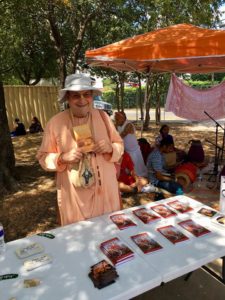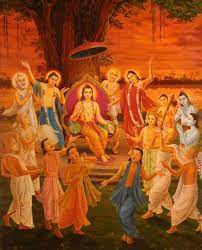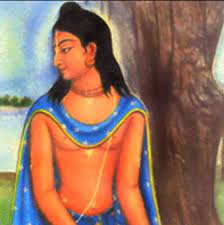Most of us discover at a fairly young age that the world is not a bed of roses. The carefree joys of childhood were brutally interrupted for me when I was just seven and I lost my mother. Navigating my way through an uncertain world after that, I encountered much more pain in the shape of a less than loving stepmother. It was enough to make me rather circumspect about the prospects of a trouble-free life. I tried to make the best of it, of course, but it was only when I came across the messages of the Bhagavad-gita that things began to make sense. Learning that the material world is intrinsically a place of suffering and that we belong somewhere else came as a great relief. It wasn’t that I was exceptionally unfortunate; all of us are in the same rocking boat, according to the Gita.
The pandemic has brought that message home all too starkly for many of us. It has been a particularly difficult time, and for some it has brought terrible grief. A workmate lost four members of his family to Covid, at a time when it was not possible to be with them at the last or even perform their funeral rites. Such pain is hard to imagine, although as a practising Muslim he found comfort in his faith, accepting it as the Lord’s supreme and inscrutable will. Thankfully, I have not had to endure such loss during the pandemic; although recalling my own trauma of losing my mother, I could at least relate to the pain a little. Grief is the hardest of all sufferings, according to the Mahabharat. It robs us of our senses and very ability to function. When a loved one dies, it leaves a gaping hole in your life. Going back to normal is near impossible, and you have to learn how to somehow cope with a new reality.
Like my work friend though, we can find solace in the words of scripture. The Gita tells us we are all eternal souls, temporarily dwelling in mortal frames. It therefore shocks us when suddenly something we took for granted as a part of our lives is cruelly taken from us. We can’t easily process it, as we are meant for eternal existence where nothing and no one ever passes away. Again, the Gita’s message is that we belong to the spiritual world, the abode of God, our ever-loving father and friend. Somehow we have fallen from there to this world of ever-shifting sands where nothing stays the same and everything we hold dear is lost in time.
This is ultimately the cause of all anxiety. Many of us have also had to deal with this and even bouts of depression during these difficult times. Anxiety is really just uncertainty—‘what will happen?’—and this stems from us knowing that we really don’t have any control. The world is rapidly changing even as we watch; we can’t hold onto anything and so often we have to accept things we never bargained for or wanted. This can be depressing at times; we want life to be predictable and certain, to bring happy things and joy, but sadly that is not always the way it happens.
There are some powerful instructions in this regard in the Ramayana. Some time after Lord Rama was banished to the forest, his brother Bharata brought him the news of his father’s passing. Rama was distraught to hear this, a grief that was compounded by his feelings of guilt at not having been there when he died, and not being able to conduct his funeral ceremony. He censured himself and lamented loudly, but seeing that the many others present were also giving way to sorrow to see him grieve, he gradually calmed his mind and began to speak profound words of consolation. “In this world the embodied soul is moved by the all-powerful force of Providence,” said Rama. “No one can control that power. All gains must end in loss, every meeting ends in separation and all life has its end in death.”
It is perhaps a hard message, but its truth is undeniable. Rama also pointed out that the power to prevent one’s own death does not exist in one grieving for another. C.S.Lewis said, “No one ever told me that grief felt so much like fear.” We know that the fate that befell those we have lost awaits us all. The Gita therefore tells us to strive for the eternal, get free of this world of suffering where we do not belong.
But even while we are in this world we can find tranquility by following the guidance of the Gita. It tells us that complete peace comes when we realise three things. The first is that our real happiness lies in serving the Supreme, not in our own attempts to enjoy. The more we try to exploit this world for our happiness, the more we suffer. This is becoming all too apparent as we witness global events like climate change and of course the pandemic unfolding around us. But the Gita assures us that when we give ourselves to divine service these problems will vanish, and a deep sense of joy and satisfaction begins to envelop us.
The second key point is that we are not the controllers. As they say, ‘your anxiety will end when you accept that you are not the general manager of the universe’. As Rama pointed out, the all-powerful force of Providence or God controls this world and indeed us. Everyone is trying to be happy, but still we see so much suffering. Why? The Gita says it is because we do not recognise God’s control and follow his guidance, which is meant for our greatest good. Which leads to the last point, the Lord is our truest friend. This one can sometimes be hard to understand. When things go wrong in life and we face difficulties, it tests our faith. “Why has God done this to me?” Or to our loved ones, especially when we are trying our best to be good people. But we must know that Krishna is preparing us for far greater things than we can even imagine. There will surely be some tests, but when see God’s hand working they become uplifting and transformational. Pressure turns coal into diamonds, and we are all diamonds in the rough, waiting to shine again in our original brilliance.
The strength we need will come from Krishna if we constantly connect with him through our practises. This can also greatly help in alleviating the strain on our relationships that the lockdown has so often brought on us. My spiritual teacher Srila Prabhupada said that the brotherhood of man will come when accept the common fatherhood of God. When we pray together, we stay together. But even if our family members do not join us and it is just us alone practising, we will still see wondrous changes around us as we begin to change. By realising the three points above our aching hearts will become assuaged, all anxieties will be dispelled, and we will find true and lasting peace.










 By Badrinarayan Swami, Arcita and Dravida Prabhus
By Badrinarayan Swami, Arcita and Dravida Prabhus























 By Mayapur Sasi dasa
By Mayapur Sasi dasa





